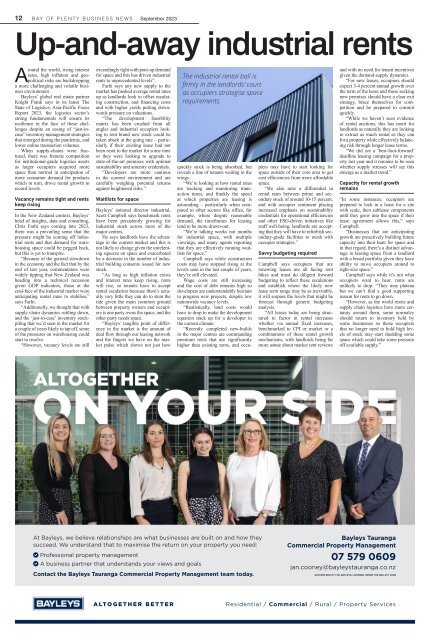September 2023 - Bay of Plenty Business News
From mid-2016 Bay of Plenty businesses have a new voice, Bay of Plenty Business News. This publication reflects the region’s growth and importance as part of the wider central North Island economy.
From mid-2016 Bay of Plenty businesses have a new voice, Bay of Plenty Business News. This publication reflects the region’s growth and importance as part of the wider central North Island economy.
You also want an ePaper? Increase the reach of your titles
YUMPU automatically turns print PDFs into web optimized ePapers that Google loves.
12 BAY OF PLENTY BUSINESS NEWS <strong>September</strong> <strong>2023</strong><br />
Up-and-away industrial rents<br />
Around the world, rising interest<br />
rates, high inflation and geopolitical<br />
risks are backdropping<br />
a more challenging and volatile business<br />
environment.<br />
<strong>Bay</strong>leys’ global real estate partner<br />
Knight Frank says in its latest The<br />
State <strong>of</strong> Logistics: Asia-Pacific Focus<br />
Report <strong>2023</strong>, the logistics sector’s<br />
strong fundamentals will ensure its<br />
resilience in the face <strong>of</strong> these challenges<br />
despite an easing <strong>of</strong> “just-incase”<br />
inventory management strategies<br />
that emerged during the pandemic, and<br />
lower online transaction volumes.<br />
When supply-chains were fractured,<br />
there was frenetic competition<br />
for institutional-grade logistics assets<br />
as larger occupiers acquired more<br />
space than normal in anticipation <strong>of</strong><br />
more consumer demand for products<br />
which in turn, drove rental growth to<br />
record levels.<br />
Vacancy remains tight and rents<br />
keep rising<br />
In the New Zealand context, <strong>Bay</strong>leys’<br />
head <strong>of</strong> insights, data and consulting,<br />
Chris Farhi says coming into <strong>2023</strong>,<br />
there was a prevailing sense that the<br />
pressure might be coming <strong>of</strong>f industrial<br />
rents and that demand for warehousing<br />
space could be pegged back,<br />
but this is yet to transpire.<br />
“Because <strong>of</strong> the general slowdown<br />
in the economy and the fact that by the<br />
end <strong>of</strong> last year, commentators were<br />
widely tipping that New Zealand was<br />
heading into a technical recession<br />
given GDP indicators, those at the<br />
coal-face <strong>of</strong> the industrial market were<br />
anticipating rental rates to stabilise,”<br />
says Farhi.<br />
“Additionally, we thought that with<br />
supply chain dynamics settling down,<br />
and the ‘just-in-case’ inventory stockpiling<br />
that we’d seen in the market for<br />
a couple <strong>of</strong> years likely to tap <strong>of</strong>f, some<br />
<strong>of</strong> the pressures on warehousing could<br />
start to resolve.<br />
“However, vacancy levels are still<br />
exceedingly tight with pent-up demand<br />
for space and this has driven industrial<br />
rents to unprecedented levels”.<br />
Farhi says any new supply to the<br />
market has pushed average rental rates<br />
up as landlords look to <strong>of</strong>fset escalating<br />
construction, and financing costs<br />
and with higher yields putting downwards<br />
pressure on valuations.<br />
“The development feasibility<br />
matrix has been crushed from all<br />
angles and industrial occupiers looking<br />
to rent brand new stock could be<br />
taken aback at the going rate – particularly<br />
if their existing lease had not<br />
been reset to the market for some time<br />
or they were looking to upgrade to<br />
state-<strong>of</strong>-the-art premises with optimal<br />
sustainability and amenity credentials.<br />
“Developers are more cautious<br />
in the current environment and are<br />
carefully weighing potential returns<br />
against heightened risks.”<br />
Waitlists for space<br />
<strong>Bay</strong>leys’ national director industrial,<br />
Scott Campbell says benchmark rents<br />
have been persistently growing for<br />
industrial stock across most <strong>of</strong> the<br />
major centres.<br />
He says landlords have the advantage<br />
in the current market and this is<br />
not likely to change given the unrelenting<br />
squeeze on space and exacerbated<br />
by a decrease in the number <strong>of</strong> industrial<br />
building consents issued for new<br />
stock.<br />
“As long as high inflation exists<br />
and interest rates keep rising, rents<br />
will rise, so tenants have to accept<br />
rental escalation because there’s actually<br />
very little they can do to stem the<br />
tide given the main common ground<br />
between property owners and occupiers<br />
is one party owns the space, and the<br />
other party needs space.<br />
“<strong>Bay</strong>leys’ tangible point <strong>of</strong> difference<br />
in the market is the amount <strong>of</strong><br />
deal flow through our leasing network<br />
and the fingers we have on the market<br />
pulse which shows not just how<br />
The industrial rental ball is<br />
firmly in the landlords’ court<br />
as occupiers strategise space<br />
requirements.<br />
quickly stock is being absorbed, but<br />
reveals a line <strong>of</strong> tenants waiting in the<br />
wings.<br />
“We’re looking at how rental rates<br />
are tracking and monitoring transaction<br />
times, and frankly the speed<br />
at which properties are leasing is<br />
astounding – particularly when compared<br />
to other sectors like <strong>of</strong>fice, for<br />
example, where despite reasonable<br />
demand, the timeframes for leasing<br />
tend to be more drawn-out.<br />
“We’re talking weeks not months<br />
for industrial space, with multiple<br />
viewings, and many agents reporting<br />
that they are effectively running waitlists<br />
for space.”<br />
Campbell says while construction<br />
costs may have stopped rising at the<br />
levels seen in the last couple <strong>of</strong> years,<br />
they’re still elevated.<br />
Wage costs are still increasing<br />
and the cost <strong>of</strong> debt remains high so<br />
developers are understandably hesitant<br />
to progress new projects, despite low<br />
nationwide vacancy levels.<br />
“Realistically, land costs would<br />
have to drop to make the development<br />
equation stack up for a developer in<br />
the current climate.<br />
“Recently completed new-builds<br />
in the major centres are commanding<br />
premium rents that are significantly<br />
higher than existing rents, and occupiers<br />
may have to start looking for<br />
space outside <strong>of</strong> their core area to get<br />
cost efficiencies from more affordable<br />
space.<br />
“We also note a differential in<br />
rental rates between prime and secondary<br />
stock <strong>of</strong> around 10-15 percent,<br />
and with occupier sentiment placing<br />
increased emphasis on sustainability<br />
credentials for operational efficiencies<br />
and other ESG-driven initiatives like<br />
staff well-being, landlords are accepting<br />
that they will have to refurbish secondary-grade<br />
facilities to mesh with<br />
occupier strategies.”<br />
Savvy budgeting required<br />
Campbell says occupiers that are<br />
renewing leases are all facing rent<br />
hikes and must do diligent forward<br />
budgeting to reflect these escalations<br />
and establish where the likely new<br />
lease term range may be as inevitably,<br />
it will surpass the levels that might be<br />
forecast through generic budgeting<br />
analysis.<br />
“All leases today are being structured<br />
to factor in rental increases<br />
whether via annual fixed increases,<br />
benchmarked to CPI or market or a<br />
combinations <strong>of</strong> these rental growth<br />
mechanisms, with landlords being far<br />
more astute about market rent reviews<br />
and with no need for tenant incentives<br />
given the demand-supply dynamics.<br />
“For new leases, occupiers should<br />
expect 3-4 percent annual growth over<br />
the term <strong>of</strong> the lease and those seeking<br />
new premises should have a clear exit<br />
strategy, brace themselves for competition<br />
and be prepared to commit<br />
quickly.<br />
“While we haven’t seen evidence<br />
<strong>of</strong> rental auctions, this has merit for<br />
landlords as naturally they are looking<br />
to extract as much rental as they can<br />
for a property while effectively balancing<br />
risk through longer lease terms.<br />
“We did see a ‘best-foot-forward’<br />
deadline leasing campaign for a property<br />
last year and it remains to be seen<br />
whether supply stresses will see this<br />
emerge as a market trend.”<br />
Capacity for rental growth<br />
remains<br />
“In some instances, occupiers are<br />
prepared to lock in a lease for a site<br />
with scale, then sublease components<br />
until they grow into the space if their<br />
lease agreement allows this,” says<br />
Campbell.<br />
“<strong>Business</strong>es that are anticipating<br />
growth are proactively building future<br />
capacity into their hunt for space and<br />
in that regard, there’s a distinct advantage<br />
in leasing space from a landlord<br />
with a broad portfolio given they have<br />
ability to move occupiers around to<br />
right-size space.”<br />
Campbell says while it’s not what<br />
occupiers want to hear, rents are<br />
unlikely to drop. “They may plateau<br />
but we can’t find a good supporting<br />
reason for rents to go down.<br />
“However, as the world resets and<br />
supply chain logistics have more certainty<br />
around them, some normalcy<br />
should return to inventory held by<br />
some businesses so those occupiers<br />
that no longer need to hold high levels<br />
<strong>of</strong> stock may start shedding some<br />
space which could take some pressure<br />
<strong>of</strong>f available supply.”<br />
At <strong>Bay</strong>leys, we believe relationships are what businesses are built on and how they<br />
succeed. We understand that to maximise the return on your property you need:<br />
Pr<strong>of</strong>essional property management<br />
A business partner that understands your views and goals<br />
Contact the <strong>Bay</strong>leys Tauranga Commercial Property Management team today.<br />
<strong>Bay</strong>leys Tauranga<br />
Commercial Property Management<br />
07 579 0609<br />
jan.cooney@bayleystauranga.co.nz<br />
SUCCESS REALTY LTD, BAYLEYS, LICENSED UNDER THE REA ACT 2008<br />
ALTOGETHER BETTER<br />
Residential / Commercial / Rural / Property Services
















